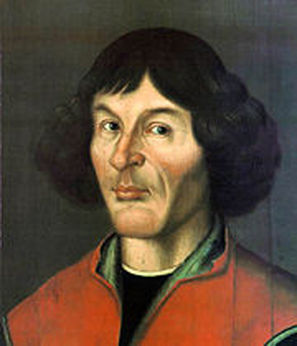Nicolaus Copernicus

Nicolaus Copernicus was born in the city of Torun, Poland on February 19, 1473. Copernicus was raised by his uncle, Lucas Watzenrode, the bishop and ruler of Ermland, and the man who was responsible for his education. Copernicus studied mathematics, astronomy and astrology at the University of Cracow in 1491. In 1496 Copernicus attended the University of Bologna. While he studied at Bologna he made his first astronomical observation. Copernicus was well known for his creation of the heliocentric theory. The heliocentric theory is based on the concept that the sun was the center of the solar system. The planets revolved around the sun; however, the moon revolved around the Earth. Copernicus started modern astronomy.
The discovery of the heliocentric theory conflicted with Ptolemy's geocentric theory, based on the concept of the Earth being at the center of the solar system. Ptolemy's geocentric theory was accepted by the Catholic Church, and the main belief of astronomy during that era. Copernicus chose not to publish his theory because he feared being persecuted and charged with heresy by the Catholic Church. The church's faith strongly disagreed with Copernicus' theory. They believed if the heliocentric theory was published, people would question the church's authority. Galileo Galilei, was a European astronomer who believed Copernicus' theory. Johannes Kepler was a German mathematician who challenged the geocentric theory. He practiced the teachings of Copernicus' theory, but made one correction. The orbits were elliptical with the sun toward the end of the ellipse rather than at the center. In May 1543, Copernicus published his book, On the Revolutions of the Heavenly Spheres, which contained his mathematical proofs. This book was dedicated to Pope John III. Nicolaus Copernicus died from an unknown disease on May 24, 1543, but his heliocentric theory is still studied today.
The discovery of the heliocentric theory conflicted with Ptolemy's geocentric theory, based on the concept of the Earth being at the center of the solar system. Ptolemy's geocentric theory was accepted by the Catholic Church, and the main belief of astronomy during that era. Copernicus chose not to publish his theory because he feared being persecuted and charged with heresy by the Catholic Church. The church's faith strongly disagreed with Copernicus' theory. They believed if the heliocentric theory was published, people would question the church's authority. Galileo Galilei, was a European astronomer who believed Copernicus' theory. Johannes Kepler was a German mathematician who challenged the geocentric theory. He practiced the teachings of Copernicus' theory, but made one correction. The orbits were elliptical with the sun toward the end of the ellipse rather than at the center. In May 1543, Copernicus published his book, On the Revolutions of the Heavenly Spheres, which contained his mathematical proofs. This book was dedicated to Pope John III. Nicolaus Copernicus died from an unknown disease on May 24, 1543, but his heliocentric theory is still studied today.
